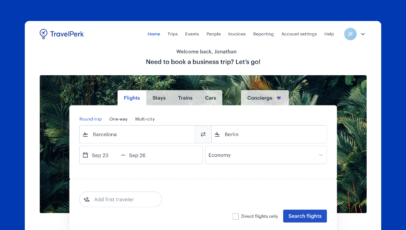As a travel manager, you have access to swathes of employee travel data. Each time an employee travels for business, a huge amount of data is created, from how much the trip cost and how it was booked, to which vendors were used and how closely the trip complied with your corporate travel policy.
All of this data provides you with the insight you need to track key performance indicators (KPIs) for travel management. Usually, organizations will decide which KPIs for travel management to focus on by ensuring that they align with their travel budgets, overall business travel goals, and travel industry benchmarks.
It’s your job to not only establish and monitor the right travel management KPIs for your organization but also to leverage the results and turn them into actionable insights to help optimize your travel management program.
So, which KPIs for travel management are most important to measure? Here, we go through 8 travel management KPIs that we think are crucial for most organizations.
What types of KPIs for travel management should you be measuring?
Many organizations view measuring travel KPIs as a way to reduce costs or optimize the way they use their travel budget. However, although cost savings are important, we believe that there are three broad types of corporate travel metrics that all organizations should incorporate into their travel management KPIs.
Financial metrics
These metrics are concerned with how organizations can save money and protect their bottom line and stakeholders. For example, this category covers KPIs that measure policy compliance, overspend outside of booking tools, total spend, and cost savings.
How TravelPerk makes tracking travel spend simple
The only way to truly stay on top of your business travel budget, is with access to real-time reporting. With TravelPerk’s sophisticated reporting tools you can break costs down by employee, team, travel type, average trip cost, recoverable VAT, and more.
Quality metrics
Quality metrics cover KPIs that relate to employee satisfaction. For example, KPIs of this type measure traveler satisfaction, traveler engagement with approved booking platforms, and SLA agreement satisfaction by vendors.
Business metrics
Finally, business metrics cover ROI and productivity KPIs. For example, organizations can measure trip success rate, productivity rate, and the impact on travel within departments to gauge how successful their travel program is.
8 Top KPIs for travel management
Now that we’ve covered the most important travel management KPI categories, below, we go through 8 KPIs that your organization should measure to evaluate the effectiveness of their corporate business travel policy.
If your company doesn’t have a travel policy, feel free to refer to our sample company travel policy for employees to create yours.
1. Booking tool adoption
Whether you’ve invested in a booking tool or a full travel management platform, you did so with the intention of streamlining processes, ensuring compliance, and, importantly, making savings on corporate travel.
Even though you’re on board with the travel booking solution, how many of your traveling employees are using other booking channels to make travel arrangements? Measuring the percentage of employees who have fully adopted the tool as their primary method of making travel arrangements will help you evaluate how effective the online booking tool is, and the level of ROI you’re getting out of it.
Plus, your booking tool will only show employees approved suppliers that have been included in your corporate travel policy, and that likely provide you with corporate discounts. To gain better booking visibility, divide the booked and ticketed spend by your total travel spend to discover how well your organization has adopted your booking tool.

2. Use of approved methods of payment
Much like your booking tool, it’s important to get a handle on how well your employees are compliant with the forms of payment they’re using.
For example, organizations that provide their employees with a company credit card to cover business travel expenses need to know the levels of non-compliance with their payment policy. A travel and expense policy is meant to help organizations keep occupational fraud at bay, streamline the reimbursement process, and comply with IRS regulations. Plus, having approved payment methods makes it easier to monitor travel spend and identify areas for optimization.
You can measure how well your employees are adhering to your payment policy by dividing your travel-related spend on a company credit card by your total travel spend.
3. Negotiated savings
Securing corporate travel discounts is a great way for organizations to keep costs low. If you have already negotiated discounts or set rates with travel vendors (airline ticket prices, hotel rooms, car rentals) it’s a good idea for you to calculate how much you have saved by securing these partnerships.
This will help you identify which partnerships are worth continuing with and which rates could stand to be negotiated further. To measure how much you have saved by securing corporate rates and discounts, take the average market rate and subtract your negotiated rate, then multiply by the total spend at the negotiated rate.
4. Traveler satisfaction
Knowing how happy your traveling employees are is key to business success. If they aren’t happy with their travel experiences, their unhappiness is likely associated with your corporate travel program and policy. As with other areas of business, when employees are unhappy, retention rates are prone to plummet.
By requiring travelers to take regular satisfaction surveys about their travel experiences will give you insight into how well your travel policies are working. Ask them about their transportation, lodging, expense, and booking experiences to identify areas for improvement.
5. Average trip spend by project or team
Analyzing how concentrated your organization’s travel spend is will help you identify whether specific projects or teams are spending more than other departments. This will then help you analyze the return on investment (ROI) on these trips -- maybe one department is spending more than others because they’ve just secured a huge contract.
However, you may also find that regular travel to one destination isn’t providing much business value, and travel budgets may need to be adjusted.
6. Percentage of changes, rebookings, and cancelations
Where possible, you want to avoid making any changes to bookings since they usually incur steep charges and additional spend.
Take a look at the percentage of rebookings, changes, and cancelations during a specific period. This will give you an idea of whether there are certain times of the month or year where changes to bookings occur, whether they can be attributed to specific departments, and what reasons were given for the changes. Form there, you can consider how best to reduce the total amount of changes made to original bookings.
7. Percentage of advance bookings
Booking ahead saves organizations money and generally gives them more flexibility and choice with their travel arrangements. As much as possible, your employees should be booking travel as far in advance as is possible.
Of course, last-minute bookings can always arise. But, if you take a look at how many days in advance travel arrangements are made on average, you’ll get a picture of whether you need to adjust your travel processes and/or policies.
8. Number of travel incident reports
You have a legal obligation, known as duty of care, to keep your employees safe when they travel. This includes having travel risk management policies in place that address risks like political unrest, illness (including the COVID-19 pandemic), regional security concerns, and entry requirements.
Take a good look at the total number of incident reports over a specific timeframe to gauge just how safe your employees are when they travel. Plus, be proactive about any extra measures you can put in place to ensure their safety during any future business trip.
For more information on how to establish and measure corporate KPIs for travel management, check out our detailed eBook: Top metrics for measuring a corporate travel program.
Did you find this article useful?
If you did, please follow us on our social media accounts on LinkedIn or Instagram. Please share the article with your friends or colleagues!
Speak to a travel expert
Want to know how we can take your business travel to the next level? Schedule a live, personalized demo with a TravelPerk expert to find out.




